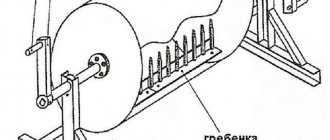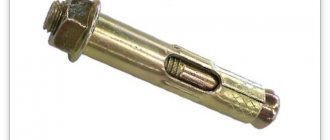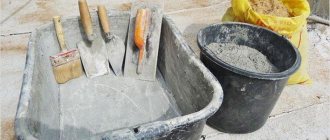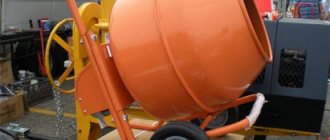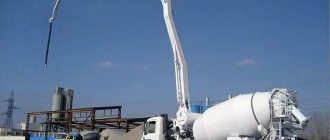A forced-action concrete mixer is one of the most common types of equipment used for quick, simple and high-quality mixing of concrete solutions. Kneading any building mixture manually requires serious time and labor, and the result does not always correspond to norms and standards. Using a concrete mixer can not only significantly simplify and speed up the process, but also achieve better quality of the solution.
According to the principle of operation, concrete mixers are of forced and gravitational action. Forced ones are considered a more acceptable and universal option, as they allow you to mix different types of solutions. But maximum productivity can be achieved when mixing fine-grained mixtures.
Buying a unit can cause serious expenses, so many people prefer to make a forced-action concrete mixer with their own hands according to ready-made drawings, from parts that can be found on the open market or made independently.
Forced and gravity concrete mixer - what is the difference?
A gravity mixer prepares a concrete mixture by rotating the ingredients in a mixing bowl equipped with two or more massive blades. The blades lift the cement-sand composition, which, under the influence of gravity, falls to the bottom of the bowl, mixing. After a certain number of rotation cycles, a ready-to-use concrete mixture is obtained.
External view of an industrial forced-action planetary mixer Source Expertfasada.ru
In the case of preparing a cement-sand mortar with coarse aggregate, such as granite or limestone crushed stone, the finished concrete is well mixed. But if it is necessary to prepare a solution with fine aggregate or light ingredients, for example, sawdust, the forces of gravity are not enough to thoroughly mix the solution. It separates or sticks together into lumps, not reaching the required consistency.
A forced-action concrete mixer prepares concrete by forcefully mixing it with metal blades. Thanks to this, all the ingredients of the mixture are mixed most thoroughly and evenly. Some models of mixers are equipped with cascade mixing systems or a rotating bowl, which, together with rotating blades, works in a similar way to a kitchen mixer, quickly and efficiently mixing ingredients together. Various types of concrete are prepared in such units:
- wood concrete and other lightweight concrete;
- molding concrete;
- hard concrete;
- concretes with precise parameters of rigidity and plasticity.
Concrete mixer from a washing machine
This original way to get your own concrete mixer is suitable for those who have an old (but with a intact tank and a working motor) activator-type washing machine sitting idle in the barn collecting dust. These devices were equipped with a powerful engine, quite capable of not only driving water along with laundry, but also mixing concrete mixture.
All that remains is to remove the activator, replace it with a shaft with blades and seal the drain hole. The only inconvenience: you will have to unload the finished solution manually.
Forced action concrete mixer: design
A forced-action concrete mixer consists of the following main elements:
- mixing bowl;
- frames;
- electric motor-drive;
- mixing blades.
The volume of the mixing bowl can reach 2500 liters, due to which concrete mixers of this type are made of metal with a thickness of at least 6 mm.
Inside the bowl there are mixing blades Source Silteh.ru
Depending on the orientation of the bowl - vertical or horizontal, mixing units are equipped with different types of mixing devices:
- vertical single-blade;
- planetary;
- with a rotating or stationary bowl;
- horizontal rotating shafts;
- and etc.
Rotary units
Rotary concrete mixers are designed for the production of any types of mixtures with aggregate size up to 40 mm in diameter. This distinguishes it from other types of units that cannot work with such large aggregates. The general versatility and small dimensions of rotary units make them a good choice for “do-it-yourselfers”, but are absolutely not suitable for industrial production due to their low productivity.
Planetary units
The main advantage of planetary group mixers is their large capacity. With their use, it becomes possible to prepare 200 or more liters of concrete at a time. They have one significant drawback - low energy efficiency. The power of the electric motor of planetary concrete mixers is 5-12 kW, while other types of mixers are equipped with electric motors with a power of no more than 1.5 kW.
Sectional design of a planetary concrete mixer Source Beton-house.com
Manufacturing of vertical structure
Buying a ready-made unit is an expensive pleasure, so the desire to save money by making a concrete mixer with your own hands is quite understandable. But before you get started, there are some things to consider:
- Such a step will provide economic benefits only if all the necessary initial structural elements and tools for their processing are at hand. Otherwise, purchasing the necessary parts will cost more than purchasing a finished product.
- The master must have some experience working with a welding machine and grinder, and understand the basics of electrical engineering.
- Manufacturing a concrete mixer is unprofitable if it is only needed once. It is also not suitable for professional use - in the first case, it is advisable to rent the device, in the second - to purchase a factory-made unit.
If the decision is made, then first you need to stock up on details:
- a barrel of the required volume (for example, 200 liters);
- shaft with blades;
- engine (4 kW);
- drive;
- gearbox;
- elements for assembling the control panel.
The tools you will need are a welding machine, a grinder and a drill.
The work of constructing a concrete mixer with a vertical shaft consists of certain stages.
Tank preparation
The cylindrical shape of the barrel is not entirely convenient for kneading, since a “dead zone” is formed at the junction of the sides and bottom. In addition, when trying to unload the mixture, a significant part of it will remain in the tank. It is recommended to modernize the barrel a little, giving it the shape of a bowl: for this, the top and bottom are cut off, then wedge-shaped cuts are made in the lower part, the edges of which are welded. The bottom diameter is reduced by the required amount and welded again.
We should not forget that the mixture will be unloaded from below, so care must be taken to create a hatch in the bottom. The easiest way is to give it the appearance of a retractable flap so that it fits more tightly to the bottom. The design can be supplemented with rubber pads.
The hollow tube is vertically fixed to the wall of the housing; an L-shaped handle is inserted into it, the lower end of which is welded to a flap that closes the hole in the bottom. To open the hatch and unload, just turn the handle.
Frame, drive and blades
To make the frame, you will need 4 corners, which are welded to the drum. This structural element will bear the weight of the unit itself plus the weight of the contents. It is believed that with a capacity of 60 liters, the frame will have to withstand a weight load of 200 kg. Based on this, you should take corners of sufficient thickness. It is advisable to connect the frame parts to the drum by welding.
The simplest option for locating the motor (drive) is at the top, above the container. Sometimes it is welded to the upper edge of the container (having previously strengthened it), sometimes to a vertical frame element of sufficient height. The transmission of torque from the electric motor shaft to the concrete mixer shaft will be provided by a belt or chain drive.
You should also correctly calculate the size of the blades: it should be such that there is a minimum gap between their edges and the walls of the tank. The blades should not rub against the inner surface of the barrel. It is necessary to calculate their optimal thickness: if it is too small, the blades will quickly bend, and if the thickness is excessive, the weight of the structure will increase and a larger engine will be required.
Units of famous brands
The Russian market offers a wide range of mixing units, among which the following models can be noted.
| Name | Volume, l. | Weight, kg | power, kWt | Number of revolutions per minute | Price, rub |
| Zitrek RN-150 | 150 | 200 | 1500 | 37 | 71000 |
| Lebedyan RN-80 | 80 | 285 | 1500 | 39,2 | 92250 |
| Imer MIX 360 | 360 | 360 | 6200 | 36 | 389000 |
| STROYMASH RN-200A | 200 | 215 | 1500 | 35,6 | 108000 |
| MISOM SO 351-150 | 150 | 172 | 1500 | 35 | 89000 |
| Zitrek RN SB-300 | 300 | 550 | 7500 | 26 | 172000 |
| Imer SPIN 15A | 60 | 78 | 1400 | 280 | 132500 |
External view of a factory-made horizontal concrete mixer Source Kblok.ru
Useful tips
So that your efforts are not in vain, it is better to avoid mistakes when making a concrete mixer.
To do this, you must adhere to the following recommendations:
- Do not use a container with thin walls: it will quickly break down.
- Choose the right engine power, otherwise it will quickly overheat.
- Make sure that the base is strong and stable, taking into account that it will experience shocks and vibrations during operation.
- Do not place the drum too high: it will be inconvenient to use.
- Protect the engine and gearbox from getting mixture components with a casing.
- Do not neglect safety rules when working with electrical appliances.
A concrete mixer, assembled according to all the rules, will serve for many years, eliminating tedious and unpleasant work.
Source
Practical experience in using a forced concrete mixer
Since the cost of factory samples of units can reach several hundred thousand rubles, the use of a forced-action concrete mixer in practice requires careful planning.
Model of a mobile concrete mixer with a protective mesh Source Maiso.ru
The purchase of such a mixer becomes economically justified when mixing at least 50-70 m3 of concrete on a construction site yourself. Therefore, the technology of building a house using such equipment implies the widespread use of concrete in all elements of the future building:
- installation of a strip or slab foundation;
- erection of walls;
- organization of blind areas, pouring concrete screeds, mauerlat;
- pouring stairs, concrete paths, car parking;
- erection of a fence;
- production of masonry, plaster and other finishing mixtures.
In all other cases, you should consider making a concrete mixer yourself.
Budget model of a vertical concrete mixer Source Stroy-podskazka.ru
Components
The simplest forced-type mixer, with a horizontal drum arrangement and an electric drive, contains the following components:
A forced-action mortar mixer with a vertical drum contains the same elements, only the frame is replaced with legs, the body is shaped like a bowl with an opening hatch for unloading, and the engine can be located on the side, bottom or top.
Is it possible to make a forced concrete mixer with your own hands?
In pursuit of savings, many home owners have implemented the manufacture of forced concrete mixers with their own hands. Regardless of the nuances, home-made units are divided into two types: horizontal and vertical.
Horizontal option
Horizontal concrete mixers are made from all kinds of metal barrels and other containers. The most labor-intensive process is the manufacture of the central shaft on which the mixing blades will be located. The blades rotate inside the barrel, ensuring high-quality mixing of the mixture. In this case, it becomes possible to simultaneously prepare a fairly large amount of the mixture, limited only by the strength of the container itself.
This version of a homemade mixer is preferable for its low cost, as well as high-quality mixing of solutions with light or fine aggregates. When building a house from wood concrete, sawdust concrete, polystyrene concrete and other lightweight concrete, preference should be given to this type of concrete mixer.
Appearance of a horizontal concrete mixer made by hand Source materialexpert.ru
Vertical option
The main element of vertical concrete mixers is a metal cylindrical tank, which must be both light so that a person can move the unit alone, and at the same time durable so that the structure can withstand the weight of the mixture. Inside the tank there is a shaft driven by an electric motor. Depending on the dimensions of the engine, it can be located either on the concrete mixer itself or connected to the shaft through an angular gearbox and a belt drive.
This version of the unit is technically more complex than the horizontal one, but it allows you to prepare several types of high-quality mixtures at once:
- heavy concrete with low moisture content;
- concrete with fine bulk aggregate: screenings, fine crushed stone or gravel.
- liquid cement, plaster and other solutions.
A vertical type concrete mixer allows you to “cover” absolutely all the needs when building a house from classical materials: brick, aerated concrete, etc. In addition, it becomes possible to mix mixtures for the production of semi-dry screed, paving slabs and other finishing materials, which will save the owner a lot of money.
Appearance of a homemade vertical concrete mixer Source vse-postroim-sami.ru
Features of the device and operation
The basic equipment of a forced mixer is standard. It includes the following nodes:
- electric motor for operating the blades;
- pear (cylindrical or conical) - a barrel for mixing materials;
- blades that wrap the mixture;
- axle (drum fixed in a stationary state);
- shaft for blade mechanisms;
- a hatch or lid on the tank to prevent the solution from leaking out during mixing.
The principle of operation of the unit is simple - all the ingredients for mixing the concrete solution are fed into the pear. The device is connected to the electrical network, and the electric motor starts. During the mixing process, the blades rotate evenly in different directions and mix the composition to the required consistency.
The cost of a homemade forced-action concrete mixer
The cost of a homemade horizontal concrete mixer consists of the following components:
- Metal barrel with a volume of 200 liters – 500 rubles.
- Electric motor 1.5 kW with supports and reduction gearbox from a walk-behind tractor – 17,500 rubles.
- Materials for metal frame, blades, shaft - 2500 rubles.
- Sealing cap, seals and bearings - 200 rubles.
Total: from 20,700 rubles.
Estimated costs for the production of a vertical concrete mixer weighing 150 kg and volume 80 liters. will be:
- Metal sheets 6 and 8 mm thick – 11,750 rubles.
- Payment for rolling and plasma cutting work – 10,300 rubles.
- Worm gear – 6500 rub.
- Turning and welding work – 5000 rubles.
- Electric motor 1.5 kW, bearings – 9500 rub.
- Paint and other materials – 4000 rubles.
Total: from 47,050 rub.
Bowl of an industrial concrete mixer with a volume of 1500 liters Source Gbitrade.ru
How does it work
Figure 2. Operation of a concrete mixer
The operating principle of a concrete mixer includes the following points:
- loading of the components for the future solution is carried out through the top;
- unloading is carried out from below, through a special channel of the container.
There are several types of design:
- mobile (mobile) devices on a wheeled platform;
- stationary option operating under increased loads.
Using a forced mixer, you can prepare a solution from the following substances:
- dry mixtures;
- wet ingredients;
- moistened components;
- products with large fractions.
For mixing highly abrasive materials, units with “armored” containers are used. The blade part of the mechanism is driven by an electric drive.
